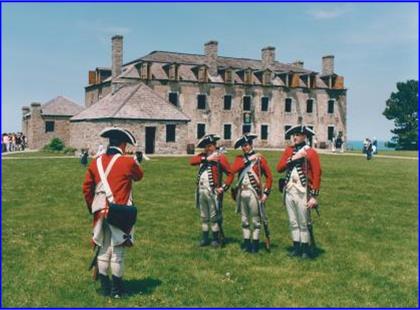Blinco Fest Update: 18 Oct — 21 Oct 2018
Thursday - check in from 4:00pm and reception
Friday - general meeting, luncheon, Old Fort Niagara tour, banquet
Saturday - Niagara Falls tour and activities
Sunday - check out by 11:00am and optional activities.
Old Fort Niagara: Friday Tour

The history of Old Fort Niagara spans more than 300 years. During the colonial wars in North America a fort at the mouth of the Niagara River was vital, for it controlled access to the Great Lakes and the westward route to the heartland of the continent. With the completion of the Erie Canal in 1825, however, the strategic value of Fort Niagara diminished. It nonetheless remained an active military post well into the 20th century.
The three flags flown daily above the parade ground symbolize the nations which have held Fort Niagara. Each competed for the support of a fourth nation: the powerful Iroquois Confederacy. The French established the first post here, Fort Conti, in 1679. Its successor, Fort Denonville (1687-88) was equally short lived. In 1726 France finally erected a permanent fortification with the construction of the impressive "French Castle." Britain gained control of Fort Niagara in 1759, during the French & Indian War, after a nineteen-day siege. The British held the post throughout the American Revolution but were forced, by treaty, to yield it to the United States in 1796. Fort Niagara was recaptured by the British in 1813. It was ceded to the United States a second time in 1815 at the end of the War of 1812. This is interesting history for our English and Canadian friends. Unfortunately, the Brits burned down Ed's hometown!
This was Fort Niagara's last armed conflict, and it thereafter served as a peaceful border post. The garrison expanded beyond the walls following the Civil War. Fort Niagara was a barracks and training station for American soldiers throughout both World Wars. The last army units were withdrawn in 1963. Today, the U.S. Coast Guard represents the only military presence on the site.
Old Fort Niagara was restored between 1926 and 1934.
Another interesting history snippet: is right where we are lodging. The Niagara Crossing Hotel & Spa is right on the Niagara River between the USA and Canada and named Niagara Crossing as it was an end point of The Underground Railroad where slaves were sheltered and then smuggled across the river to freedom.
Room Rates as quoted in the May newsletter refer to price per room not per person. A light Breakfast is included.
More detailed information will be revealed in future newsletters.